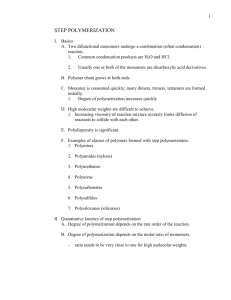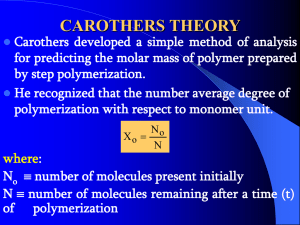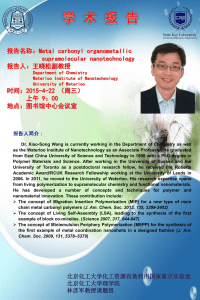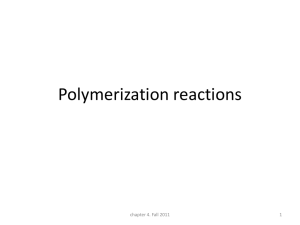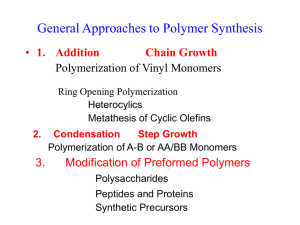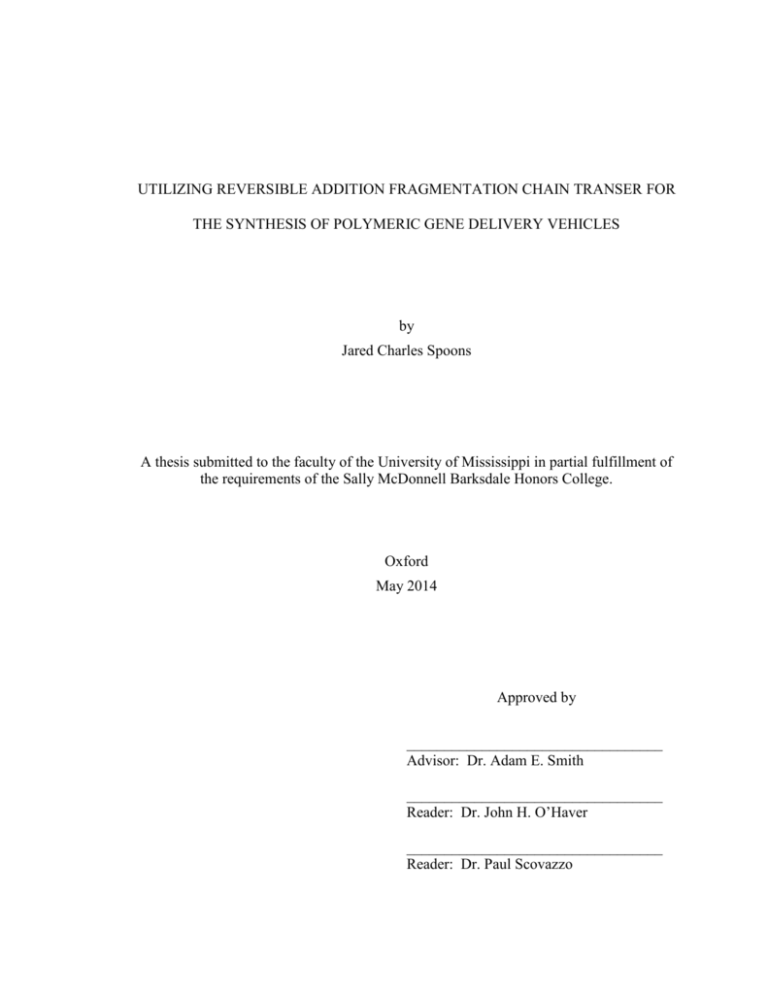
UTILIZING REVERSIBLE ADDITION FRAGMENTATION CHAIN TRANSER FOR
THE SYNTHESIS OF POLYMERIC GENE DELIVERY VEHICLES
by
Jared Charles Spoons
A thesis submitted to the faculty of the University of Mississippi in partial fulfillment of
the requirements of the Sally McDonnell Barksdale Honors College.
Oxford
May 2014
Approved by
__________________________________
Advisor: Dr. Adam E. Smith
__________________________________
Reader: Dr. John H. O’Haver
__________________________________
Reader: Dr. Paul Scovazzo
© 2014
Jared Charles Spoons
ALL RIGHTS RESERVED
ii
DEDICATION
This thesis is dedicated to the faculty of the University of Mississippi School of
Engineering, Department of Chemical Engineering, and the Sally McDonnell Barksdale
Honors College as well as to my parents, Charles and Sheree Spoons, my grandmother
Helen Messana, and my fiancée, Jessica Domaleski, all of whose endless support,
guidance, and encouragement has made achieving my dreams possible.
iii
ACKNOWLEDGEMENTS
I express my deepest appreciation to my advisor, Dr. Adam Smith and to my
committee members, Dr. John O’Haver and Dr. Paul Scovazzo. I could not have
financed my education without the scholarships provided by the Department of Chemical
Engineering and Air Force Reserve Officer Training Corps Detachment 430.
Lastly, I acknowledge the encouragement and support from my fellow
engineering students, Detachment 430 Cadet Cadre, and Colonel Bill Berry. You have
made this part of my life enjoyable, enriching, and rewarding.
iv
ABSTRACT
There are many techniques used today to make a variety of polymers but this
thesis investigates the reversible addition-fragmentation chain transfer (RAFT)
polymerization technique and illustrates the advantages and importance of using RAFT
polymerization technique to make the desired polymer. The research focused on two
monomer units that were to form the diblock copolymer; the hydrophilic part,
oligo(ethylene glycol) methacrylate, and the cationic hydrophobic part 2diethylaminoethyl methacrylate. The goal was to produce a target diblock copolymer
with a Mn value of 44K and a PDI under 1.5 with the block sizes being a 35K Mn
OEGMA chain and a 9K Mn DEAEMA chain. Using RAFT polymerization, I was able
to make the desired diblock copolymer. Using this data, I can synthesize additional block
copolymers depending on the need. This ability along with the advantage of being able
to be used in a variety of conditions is why RAFT polymerization is such an important
and desirable technique in making polymers.
v
TABLE OF CONTENTS
COPYRIGHT..................................................................................................................... ii
DEDICATION.................................................................................................................. iii
ACKNOWLEDGMENTS................................................................................................. iv
ABSTRACT........................................................................................................................ v
LIST OF FIGURES.......................................................................................................... vii
LIST OF ABBREVIATIONS………………………………….………………………... ix
INTRODUCTION ..............................................................................................................1
EXPERIMENTAL SECTION............................................................................................ 6
RESULTS/ DISCUSSION............................................................................................... 14
CONCLUSION/ LIMITATIONS..................................................................................... 26
LIST OF REFERENCES.................................................................................................. 27
vi
LIST OF FIGURES
1. Difference in chain length control and PDI for polymerization via RAFT
polymerization compared to traditional radical polymerization...................................... 3
2. Proposed mechanism for RAFT polymerization …………….…………..…………..4
3. P(OEGMA-b-DEAEMA) polymeric RAFT species ……………………..…………..5
4. MaxQ 2000 heating block used in lab for polymerization process at 70oC………….7
5. Labconco FreeZone 1 lyophilizer used to sublime water from the polymer at 0.021
mbar and -52oC ………………………….………….…………………………………….9
6. Cross sectional view of a GPC column ………………………………………………12
7. Block diagram of overall schematic of a GPC unit ……………………………….....13
8. Ultimate 3000 Injector and pump (left), columns (middle), and detectors (right)
comprising the Dionex GPC unit used in lab experiments…………..………………….13
9. Normalization of refactive index peaks verses time for five hour kinetics experiment
polymerization of P(OEGMA)………………………………… ………………...……..14
10. P(OEGMA) Mn values verses polymerization time for 5 hour kinetic run shown in
Figure 9…………………………………………………………….…………………….15
11. Normalization of refractive index vs time five hour kinetics experiment
polymerization of DEAEMA sample 1……….……………………………….…………16
vii
12. P(DEAEMA) sample 1 Mn values versus polymerization time..…………… ….….17
13. Normalization of reactive index for five hour kinetics experiment polymerization of
DEAEMA sample 2…………………………………………………..……………….…17
14. P(DEAEMA) sample 2 Mn values versus polymerization time ………………….…18
15. Purified five hour polymerization of DEAEMA with an Mn of 11K and a PDI of
1.094……………………………………………………………………………..……….19
16. Mn values of OEGMA vs polymerization time for the prediction of desired polymer
size ………..….……………………………………………………………………….…20
17. The blue peaks is a 2.5 hour P(OEGMA) with a Mn of 34K and a PDI of 1.216 and
the red peak is a 5 Hour P(OEGMA) with a Mn of 46K and a PDI of 1.008…………...20
18. Illustration of GPC characterization of P(OEGMA) 5 hour polymerization purified
sample with an Mn of 32K and a PDI of 1.220………………………………………….21
19. Degree of polymerization achieved for P(OEGMA-b-DEAEMA) for 2 and 5 hour
polymerization time……………………………………………………………………...22
20. P(OEGMA-b-DEAEMA) GPC characterization with red peak being 2hr run with an
Mn of 40K and a PDI of 1.294 and the 5hr blue peak having an Mn of 43K and PDI of
1.268……………………………………………………………………………………...23
21. P(DEAEMA-b-OEGMA) siRNA uptake and micelle formation and release theory.25
viii
LIST OF ABBREVIATIONS
CDP
4-cyano-4[(dodecyl-sulfanylthiocarbonyl)sulfanyl] pentanoic acid
CTA
chain transfer agent
DEAEMA
2-diethylaminoethyl methacrylate
DI
deionized
DMF
dimethylformamide
DMSO
dimethyl sulfoxide
dn/dc
refractive index increment [mL/g]
DP
degree of polymerization
GPC
gel permeation chromatography
g/mol
grams per mole
K
one thousand
mg
milligrams
mL
milliliters
Mn
number-average molecular weight
OEGMA
oligo(ethylene glycol) methacrylate
PDI
polydispersity index
RAFT
reversible addition-fragmentation chain transfer
siRNA
small interfering ribonucleic acid
ix
INTRODUCTION
Polymers are large molecules comprised of many structural repeat units called
monomers joined together by either ionic, covalent, hydrogen, or London dispersion
bonds. Most often, when polymers are formed, they form as long chains; however, they
can branch or form star shapes. Polymers are found throughout nature and in our
everyday lives. They can be naturally occurring or synthetic. Some examples of
naturally occurring polymers include DNA, RNA, and proteins. Examples of synthetic
polymers include nylon and polystyrene. Man has been synthesizing polymers since
1832 [1] and synthetic polymers are now commonly being used in various applications
including agriculture, industry, sports, and medicine. There are a number of techniques
used today to make a variety of polymers but the technique used for this research was
reversible addition-fragmentation chain transfer (RAFT) polymerization. RAFT
polymerization is a form of controlled living polymerization and was first reported in
1998[5]. The term “control” means that if the conditions for polymerization are selected
so that the chain breaking processes are insignificant compared to the chain propagation,
the synthesis of polymers with predetermined molecular weights and low polydisperisty
become a reality[2]. The term “living” polymerization indicates that all the chains retain
their active center after the full consumption of the monomer which will allow for
propagation to resume upon the introduction of additional monomer [2]. Additionally,
RAFT polymerization technique can be applied to a variety of monomers while
1
possessing tolerance to a variety of solvents, reaction conditions, and
functionalities. RAFT polymerization utilizes chain transfer agents (CTAs) which are
organic compounds containing thiocarbonylthiol moieties that control the polymerization
process and help prevents the growing polymer chains from terminating prematurely,
thus allowing for greater chain length control. Low polydispersity index (PDI) from the
created polymers is achieved using RAFT polymerization through the control of the
CTA. PDI is the measure of the distribution of molecular mass in a given polymer
sample. Typical ranges for PDI with a perfectly mono-disperse polymer achieving a PDI
of 1.00 [9]. Chain length control consistency available using RAFT polymerization is
shown in Figure 1 [4]. The molecular weight of a RAFT polymer is controlled by the
RAFT agent. The equation below shows how the number average DP is related to the
RAFT agent (CTA) which is related to the Mn. Therefore, the molecular weight of a
polymer is controlled by the RAFT agent as shown in Equation 1.
𝑥𝑛 =
𝑀𝑛
𝑀0
𝑐∗[𝑀]
= [𝑅𝐴𝐹𝑇]𝑜
0
(1)
Equation 1. Xn is the number average degree of polymerizaion, Mn is the number
average molecular weight, Mo is the molar mass of the repeat unit, c is the fractional
monomer conversion, and RAFT is the chain transfer agent
2
Figure 1. Difference in chain length control and PDI for polymerization via RAFT
polymerization compared to Traditional Radical Polymerization [4]
The proposed mechanism for the RAFT polymerization process in illustrated in Figure 2.
The RAFT mechanism illustrates how the initiator creates a radical unit that binds to the
monomer which then transfer of the radical unit from one propagating polymeric chain to
another via the CTA.
3
Figure 2. Proposed mechanism for RAFT polymerization [5]
The use of RAFT polymerization for pH responsive micelle formation behavior
is important in the medical and pharmaceutical fields for the development of gene
delivery techniques. The concept of gene delivery has been studied since 1963 with a
variety of viral and non-viral gene delivery agents [5]. Viral delivery agents, or vectors,
proved to be toxic in clinical trials. Thus, research shifted to non-viral methods such as
polymers as gene delivery agents. Gene delivery techniques hold great potential for the
treatment of a variety of genetic disorders such as cancer [5]. Cationic polymers, which
this research focuses on, have been extensively studied, but biocompatible analogs need
to be developed due to the high toxicity of the cationic polymers, non-specific
interactions with cells, and low gene expression.
This work focused on using the RAFT polymerization technique to synthesize
diblock copolymers of oligo(ethylene glycol) methacrylate (OEGMA) and 24
diethylaminoethyl methacrylate (DEAEMA). These monomers were chosen for their
cellular uptake and their ability to form gene delivery vectors based off of pH changes.
The preliminary research focused on determining the conditions necessary to target
diblock copolymers comprised of a block of 35K OEGMA and a 9K DEAEMA. The
structure of the monomer units of OEGMA and DEAEMA with the neutral hydrophilic
monomer being the OEGMA and the cationic monomer being the DEAEMA can be
found in Figure 3. The hydrophilic monomer block is important because it acts as the
solubilizing block. P(OEGMA) maintains the overall solubility of the vector and also
acts as a steric stabilizing layer preventing micellar fusion during cross-linking [10]. The
cationic P(DEAEMA) has a strong affinity for small interfering ribonucleic acid (siRNA)
and the cationic block leads to interpolymer binding forming a micelle at pH of 8 due to
deprotenation protecting the siRNA from enzymatic degradation [11].
Figure 3. P(OEGMA-b-DEAEMA) polymeric RAFT species
5
EXPERIMENTAL SECTION
Material
OEGMA (475 g/mol) and DEAEMA (185.3 g/mol) were purchased from Sigma
Aldrich. These monomers were purified by running through an aluminum hydroxide
column prior to remove the inhibitor (mono methyl ether hydroquinone) to allow for
polymerization at 70oC. The CTA used was 4-cyano-4[(dodecylsulfanylthiocarbonyl)sulfanyl] pentanoic acid (CDP). The initiator was 4,4’-azobis(4cyanopentanoic acid) (V-501). Solvents included dimethylformamide (DMF) and
dimethyl sulfoxide (DMSO).
Synthesis of P(OEGMA-b-DEAEMA) Copolymers
The specifications for the polymerization of OEGMA were a degree of
polymerization (DP) of 75, a CTA/Initiator of 10, and monomer concentration of 0.5M.
A solution of CDP (80.3 mg), V-501 (5.5 mg), and OEGMA (7.125 mL) was mixed with
30 mL of DMSO and placed in a 50 mL cylindrical vial and capped. The cap was made
of rubber to allow for deoxygenation of the solution. A gas vent needle was inserted on
one side of the cap. This needle did not touch the liquid solution. A long needle
connected to a tank of ultra-high purity nitrogen was inserted on the other side of the cap
and extended into the solution. The solution was purged with N2 for 15-30 minutes at
room temperature. After the allotted time, the gas vent needle was removed just prior to
6
the nitrogen being turned off to insure no oxygen was allowed in. The long needle
connected to the nitrogen tank was removed from the vial. The vial was then placed onto
a heating block that was preheated to 70oC. A heating block uses a thermocouple
transmitter to provide a signal to the temperature controller which transmits this signal to
an electrical output that provides heat to the block at the desired temperature. The
heating block also acts as a stir bar by rotating the vials in a counter-clockwise rotation
allowing equal heat distribution. The block moved in a circular fashion at a constant
temperature of 70oC for 5 hours. Figure 4 shows what the heating block in the lab looks
like.
Figure 4. MaxQ 2000 heating block used in lab for polymerization process at
70oC
7
After 5 hours, the temperature and stirrer of the block was turned off and the cap
was stabbed with a gas vent needle to allow oxygen in and terminate the process. The
solution was allowed to cool at room temperature for 1 hour prior to handling. As the
vial cooled, dialysis was performed using a Spectra/Por Dialysis Membrane. The
membrane allows small molecules with a molecular weight of 3,500 or less to diffuse
through into the DI water while keeping the larger polymer inside. The membrane was
cut to the appropriate length for the volume necessary in the vial (about 4 inches) and
soaked in deionized water for 15 minutes. After 15 minutes, the membrane was tied at
one end and opened at the other forming a bag. The vial contents, now cooled, were
transferred to the membrane bag. Any content that stayed within the vial was flushed
using DI water and transferred to the membrane bag. The bag was placed in a 500 mL
beaker filled to 350-400 mL of DI water. The water in the beaker was changed at 12
hour intervals for 6 days. This insured that no other content was left within the
membrane bag besides the desired polymer. Once the bag was removed from the
deionized water, the bag was cut at the top and contents poured into a 250 mL round
bottom flask and then placed into a freezer and allowed to freeze. The contents of the
250 mL flask were frozen, and the flask was placed on the lyophilizer for 3 days. A
picture of the lyophilizer is shown in Figure 5.
8
Figure 5. Labconco FreeZone 1 lyophilizer used to sublime water from the
polymer at 0.021 mbar and -52oC
A lyophilizer works by creating a very low temperature and low pressure
environment in which an aqueous solvent, in this case water, will reach its eutectic and
sublime, leaving only the desired solute, polymer, behind [7]. After 3 days, the pure
polymer was removed from the flask and placed into a glass vial. The contents were
evaluated using the GPC. A solution of 168 μL of POEGMA (Poly-OEGMA) was mixed
with 2 mL 54/23/23 (v/v/v %) H2O/MeOH/NaOAC and filtered into the auto sampler
vials for the characterization in the GPC.
9
The specifications for the polymerization for the kinetics of DEAEMA (MW
185.3) were a DP of 100 with a CTA/Initiator of 10 and a monomer concentration of 0.5
M solution. A solution of CDP (32.3 mg), V-501 (2.24 mg), and DEAEMA (1.48 mL)
was mixed with 16 mL of DMF and placed in a 50 mL vial capped with a rubber cap.
The vial was deoxygenated with nitrogen for 15 minutes. The vial was then placed on
the heat block at 70oC with rotating motion for 5 hours with 2 mL samples taken every
hour for the allotted time. These samples where then prepared for use in the GPC. A
0.25M solution was prepared by adding 863 μL of polymer to 2 mL of 54/23/23 (v/v/v
%) H2O/MeOH/NaOAC. This solution was then filtered into the auto sampler vials and
capped for characterization using the GPC.
After the kinetics, a single five hour polymerization of DEAEMA was done on
the heating block with a target DP of 50. Once completed, the DEAEMA was placed was
poured into the Spectra/Por Dialysis Membrane and placed into a 500 mL beaker of DI
water at a pH of 3. The DI water was made acidic by adding 300 μL of hydrochloric acid
(HCl) and acidity was tested using pH strip indicators. P(DEAEMA) was allowed to
soak in the acidic water for three days with daily water changing. After the three days,
P(DEAEMA) was then placed into pure DI water for another three days with daily water
changing. Upon completion of dialysis, P(DEAEMA) was placed in a round bottom
flask and frozen so that it could then be placed on the lyophilizer. Once all the water
sublimed off, the P(DEAEMA) was extracted out of the round bottom flask and a sample
of the purified DEAEMA was then characterized by the GPC.
The synthesis of the P(OEGMA-b-DEAEMA) diblock copolymers followed a
10
similar process as described for the polymerization of OEGMA. POEGMA macroCTA
(3000 mg), 5.3 mg V-501, and 0.861 mL of DEAEMA were placed in a 50 mL vial and
polymerized and characterized as described above.
Characterization
Size exclusion chromatography was accomplished by using the GPC to determine
the number-average molecular weight (Mn) and polydispersity indices for the polymers
and diblock copolymers using an aqueous eluent of 54/23/23 (v/v/v %)
water/methanol/acetic acid with 0.1 M sodium acetate. The refractive index increments
or dn/dc values were measured using the GPC for determination of absolute pure polymer
molecular weights. The GPC is the most convenient method used for characterizing the
complete molecular weight distribution of a polymer [6]. The end use of the polymers for
this experiment requires precision in their make-up so that they can deliver the desired
performance and endure the harsh conditions of the body. The GPC allows one to be
extremely accurate with the polymer production by allowing one to look at the samples’
PDI, molecular weights, and “dn/dc” values. The dn/dc values are used to accurately
measure the samples’ absolute molecular weights using a multi-angle light scattering
instrument. The GPC works by separating molecules that were previously dissolved in
an appropriate solvent by their “effective size in solution” [6]. Inside the GPC, the
dissolved molecules are injected into a continually flowing stream of solvent (mobile
phase). The mobile phase flows past a stationary phase which is made up of millions of
rigid and highly porous particles of varying sizes. Molecules of varying sizes will elute
out of the column at different rates with the higher molecular weight molecules eluting
11
first while the smaller molecular weight molecules experience an extended flow path,
resulting in a longer retention time [6]. Figure 6 shows a cross sectional area a GPC
column.
Figure 6. Cross sectional view of a GPC column [6]
The design of the GPC system requires a variety of equipment parts. Injectors are
needed to deliver the polymer solution to the mobile phase, pumps are needed to push the
sample and solvent through the column, detectors are used to record the separation, and
data acquisition is needed to control the test automatically, record results, and perform
the desired calculations. Figure 7 shows the block diagram design of how a GPC
functions and Figure 8 shows that the GPC unit used in the lab experiments is a Dionex
Ultimate 3000.
12
Figure 7. Block diagram of overall schematic of a GPC unit [6]
Figure 8. Ultimate 3000 Injector and pump (left), columns (middle), and
detectors (right) comprising the Dionex GPC unit used in lab experiments
13
RESULTS/ DISCUSSION
For the initial OEGMA polymerization, a targeted DP of 75 at 100% conversion
was used for the research. In order to calculate the time necessary to run the
polymerization, a series of kinetic experiments was done. Kinetics experiments required
a different polymerization set up than described in the polymerization process section.
This form utilized a 250 mL round bottom flask, an oil bath at 70oC, and long nitrogen
rich syringes that were pumped so that no air entered the needle nor the flask. Samples
were taken every 30 minutes for 4 hours. The samples were then run through the GPC
where peaks were evaluated for polymers and the Mn values were calculated, from which
the DP verses time could be calculated. The results of the kinetic run for OEGMA are
Normalization of refractive
index
represented by Figure 9.
15
17
19 Time (min)21
23
30 min
60 min
90 min
120 min
150 min
180 min
210 min
Figure 9. Normalization of refactive index peaks relating to Mn values verses
time for five hour kinetics experiment polymerization of P(OEGMA)
14
P(OEGMA) Mn Values
50000
40000
30000
20000
10000
0
0
50
100
150
200
250
Time (min)
Figure 10. P(OEGMA) Mn values verses polymerization time for 5 hour kinetic
run shown in Figure 9
The peaks shown were standardized to a value of 1. This was done to show that
as time increased, the molecular weight of the polymer also increased because the elution
time decreased. The other irregular peaks to the right of the results are solvent peaks that
were recorded as the solvent was pushed through the column.
This type of polymerization setup proved to be very challenging. To control the
temperature of the oil bath a thermometer was connected to the heating plate. However,
due to accidental shut downs, the temperature of the oil bath dropped below 70oC halting
the polymerization process leading to inaccurate results. Additionally, it was very
difficult to keep oxygen out of the syringe and round bottom flask during each sample
uptake. It was important to keep oxygen out of the polymer because the oxygen
terminates the active chain ends and ultimately the polymerization process. There was
always a degree of uncertainty regarding the amount of oxygen contamination which
could occur during each sample uptake.
15
Different molarities and CTA/initiator values were tested to determine which
yielded the desired results. At a DP of 75, a 0.5 Molar solution with a CTA/initiator ratio
of 10 undergoing a five hour polymerization produced a Mn value of 32.3K. The
maximum Mn value that theoretically could have been achieved for the given DP was
35K, therefore it was determined that these conditions were successful.
Next the DEAEMA polymerization was done at a target DP of 50 at 100%
conversion. Two kinetics tests were run for DEAEMA. The total solution size for each
test was 16 mL which was divided into six vials for the time specified for sample
collection. These runs were different from the OEGMA kinetic runs as they were done
on the heating block with samples terminated by oxygen at the allotted time. The
samples were run through the GPC with results normalized. Data from the two samples
Normalization of refractive index
are shown in Figures 11 through Figure 14.
1.4
1.2
1
1 hr
0.8
2 hr
0.6
3 hr
0.4
4 hr
0.2
5 hr
0
25
27
29
31
33
35
Time (min)
Figure 11. Normalization of refractive index for five hour kinetics experiment.
polymerization of DEAEMA sample 1
16
1650
1600
DEAEMA Mn Values
1550
1500
1450
1400
1350
0
1
2
3
4
5
6
Time (hrs)
Figure 12. P(DEAEMA) sample 1 Mn values versus polymerization time
Normalization of refractive index
1.4
1.2
1
1 hr
0.8
2 hr
3 hr
0.6
4 hr
0.4
5 hr
0.2
0
25
27
29
31
33
35
Time (min)
Figure 13. Normalization of reactive index for five hour kinetics experiment
polymerization of DEAEMA sample 2
17
2600
DEAEAM Mn Values
2200
1800
1400
1000
0
1
2
3
4
5
6
Tim (hrs)
Figure 14. P(DEAEMA) sample 2 Mn values versus polymerization time
The peaks of the DEAEMA samples were standardized to a value of 1. This data
further reflects the findings illustrated by the kinetics experimentation of OEGMA that as
time increased the molecular weight of the polymer also increased because elution time
decreased. The irregular peaks to the right of the normalized peaks are solvent peaks that
were recorded as the solvent was pushed through the column. From this data it was
determined that a DEAEMA polymerization should be done for five hours. The results
of the five hour polymerization process for purified DEAEMA is shown in Figure 15.
18
0.35
0.3
Light scattering relative scale
0.25
0.2
0.15
0.1
0.05
0
0
10
20
30
-0.05
40
50
60
Time (min)
Figure 15. Purified five hour polymerization of DEAEMA with an Mn of 11K and
a PDI of 1.094
The making of the desired 40K diblock copolymer of P(OEGMA-b-DEAEMA)
was achieved through the testing of different time intervals. This was not kinetic
polymerization as samples were not taken every 30 minutes; instead, the polymerization
process was allowed to continue through the desired length of time on the heat block with
no disturbances. This technique proved very effective in achieving the desired results as
it eliminated the error of oxygen contamination and the accidental errors of temperature
malfunctions. Two samples of OEGMA were prepared the same and were run for 2.5
hours and 5 hours with the results shown in Figure 16 and Figure 17.
19
50000
45000
40000
Mn Values
35000
30000
25000
20000
15000
10000
5000
0
0
1
2
3
4
5
6
Time (hours)
Figure 16. Mn values of OEGMA vs polymerization time for the prediction of
desired polymer size
0.5
0.45
Light scattering relative scale
0.4
0.35
0.3
0.25
0.2
0.15
0.1
0.05
0
-0.05
0
10
20
30
40
Time (min)
50
60
70
Figure 17. The blue peaks is a 2.5 hour P(OEGMA) with a Mn of 34K and a PDI
of 1.216 and the red peak is a 5 Hour P(OEGMA) with a Mn of 46K and a PDI of 1.008
20
This data further supports the kinetic data previously depicted in Figure 9. As the
time for polymerization increases so does the molecular weight. Figure 17 illustrates that
at 5 hours the polymer elutes from the column in 20 minutes while at 2.5 hours the
polymer does not elute from the column until 25 minutes.
However these results are from unpurified samples of OEGMA polymer. The 5
hour polymerization sample was chosen for purification with the resulting peaks from the
GPC shown in Figure 18.
1.2
Light scatering relative scale
1
0.8
0.6
0.4
0.2
0
0
10
20
30
-0.2
40
50
60
70
Time (min)
Figure 18. Illustration of GPC characterization of P(OEGMA) 5 hour
polymerization purified sample with an Mn of 32K and a PDI of 1.220
This strong peak indicates a large concentration of the desired sample. After
21
purification the OEGMA had a Mn of 32,300 with a PDI of 1.220 which indicated that a
DP of 68 was achieved. This was very close to our target molecular size of 35K and DP
of 75 and deemed a success.
This purified OEGMA was used as the macroCTA for the polymerization of the
diblock copolymer. The desired DP for the diblock copolymer was 50 and it was
theorized that this could be achieved with a 5 hour long polymerization process.
However, to verify that the polymerization process did not over shoot the desired DP;
two polymerization tests were done, one at 2 hours and the other at 5 hours. The result of
this polymerization is shown in Figure 19 and Figure 20.
50
Degree of Polymerization
45
40
35
30
25
20
15
10
5
0
0
1
2
3
4
5
6
Time (hrs)
Figure 19. Degree of polymerization achieved for P(OEGMA-b-DEAEMA) for 2 and 5
hour polymerization time
22
1.2
Light scattering relavtive scale
1
0.8
P(OEGMA-b-DEAEMA) 5
hr
0.6
P(OEGMA-b-DEAEMA) 2
hr
0.4
0.2
0
22
27
32
Time (min)
Figure 20. P(OEGMA-b-DEAEMA) GPC characterization with red peak being 2hr run
with an Mn of 40K and a PDI of 1.294 and the 5hr blue peak having an Mn of 43K and
PDI of 1.268
From the diblock results, it was determined that a 0.5 molar solution with a
CTA/initiator value of 10, and a DP of 50 running for 5 hours would produce a 8.5K Mn
of DEAEMA. The results of the OEGMA and diblock polymerizations yielded the
targeted value desired for this research, a diblock size of 44K Mn and a PDI of 1.
Using RAFT polymerization, polymers of controlled size and shape are tested for
their efficiency in vitro to discover the relationship between chemical structure and gene
expression [5]. Using RAFT polymerization I was able to make the desired size of
23
polymer block formation. Additionally, I can synthesize additional polymers either
larger or smaller to tailor the cellular uptake and gene expression. This, along with its
ability to be used in a variety of experimental set ups, is why RAFT polymerization is
such a desirable technique, especially in drug and gene delivery. These two monomer
units were chosen for their properties to form micelles when exposed to different pH
values. As mentioned previously, P(OEGMA) blocks maintain the solubility and
stabilization of the micelle unit while the P(DEAEMA) has a high affinity for siRNA
forming the micelle core at pH of 8 and dissolving at cytoplasmic pH 7.2. It is important
to efficiently condense negatively charged siRNA to the cationic block having a positive
surface charge to permit facile adsorptive endocytosis of the micelle into the cytoplasm
[12]
. The cationic P(DEAEMA) showed relatively high gene transfection efficiency in the
absence of serum proteins but was greatly reduced with the presence of these proteins.
This is because of the non-specific protein adsorption onto the positively charged surface
of the polymer/siRNA complex, ultimately diminishing the endocytic transport into the
cell. To resolve this problem the shielding and stabilization nature of the P(OEGMA)
block is added to suppress the non-specific protein interactions [12]. It is theorized that
this polymer diblock will be able to form a micelle unit containing siRNA and, upon
entering the target cell, will release its contents to the cell because of the pH shift causing
the deprotonation of the cationic DEAEMA. The theory of this transfer is illustrated in
Figure 21.
24
Figure 21. P(DEAEMA-b-OEGMA) siRNA uptake and micelle formation and release
theory
25
CONCLUSION
This research holds potential for life saving pharmaceutical applications
especially in the area of developing synthetic gene delivery vectors. The contribution this
research made to science is the knowledge of the kinetics of the RAFT polymerization
process using the monomers OEGMA and DEAEMA. With this data, this study can be
repeated by making smaller diblock polymer units with estimated Mn values via the
kinetics. The theory behind using the smaller polymer complex is for the diblock to have
more effiecient cellular uptake because for efficient cell transfection the micelle should
be 200 nm or less in diameter [12]. Once made, gel electrophoresis and H1-NMR should
be used in addition to the GPC to study the size, shape, and content of the polymer unit
made. These studies will eventually lead to in vitro testing.
26
LIST OF REFERENCES
1) "What are Polymers?." What are Polymers?. N.p., n.d. Web. 6 Apr. 2014.
<http://matse1.matse.illinois.edu/polymers/
2) "Features of Controlled "Living" Radical Polymerizations - Matyjaszewski
Polymer Group - Carnegie Mellon University." Features of Controlled
"Living" Radical Polymerizations - Matyjaszewski Polymer Group - Carnegie
Mellon University. Matyjaszewski Polymer Group, n.d. Web. 6 Apr. 2014.
<http://www.cmu.edu/maty/crp/feature-development-crp/features.html>.
3) "Polymer Molecular Weight Distribution and Definitions of MW Averages."
www.agilent.com/chem. Version 5990-7890EN. Agilent Technologies,
Inc, 10 June 2011. Web. 6 Apr. 2014.
<https://www.chem.agilent.com/Library/technicaloverviews/Public/59907890EN.pdf>.
4) "RAFT: Choosing the Right Agent to Achieve Controlled Polymerization."
Sigma-Aldrich. Sigma-Aldrich Co. LLC., n.d. Web. 6 Apr. 2014.
<http://www.sigmaaldrich.com/materials-science/polymer-science/raftpolymerization.html>.
5) Ahmed M, Narian R. Progess of RAFT based polymer in gene deliver. Prog
Polym Sci (2012), <http:// dx.doi.or/10.1016/j.progpolymsci.2012.09.008>.
27
LIST OF REFERENCES CONTINUED
6) "GPC - Gel Permeation Chromatography." : Waters. Waters, n.d. Web. 6 Apr.
2014. <http://www.waters.com/waters/en_US/GPC---Gel-PermeationChromatography/nav.htm?cid=10167568&locale=en_US>.
7) Klutts. "Lyophilizer Use." Crypto. Version 5. N.p., n.d. Web. 6 Apr. 2014.
<http://www.crypto.wustl.edu/Protocols%20PDFs/Lyophilizer%20(SK).p
df>.
8) Nobbmann, Ulf. "Refractive index increment dn/dc values." Refractive index
increment dn/dc values. Malvern, 18 June 2013. Web. 6 Apr. 2014.
<http://www.materials-talks.com/blog/2013/06/18/refractive-index-incrementdndc-values/>.
9) Young, Robert J., and P. A. Lovell. Introduction to polymers. 3rd ed. Boca
Raton: CRC Press, 2011.
10) Alarcon, Carolina, Sivanand Pennadam, and Cameron Alexander. "Chemical
Society Reviews." Stimuli responsive polymers for biomedical applications (RSC Publishing). Chemical Society Reviews, 27 July 2004. Web. 5 May
2014. <http://dx.doi.org/10.1039/b406727d>.
11) Hinton, Tracey, and Carlos Guerrero-Sanchez. "Biomaterials." The Effect of
RAFT-derived cationic block copolymer structure efficiency. Elsevier, 12
May 2012. Web. 10 Apr. 2014.
<http://dx.doi.org/10.1016/j.biomaterials.2012.06.090>.
12) Lim, Dong, Young Yeom, and Tae Park. "Poly(DEAEMA-NVP)-b-PEGgalactose as Gene Delivery Vector for Hepatocytes." Bioconjugate Chem.
28
LIST OF REFERENCES CONTINUED
Version Vol. 11, No. 5. American Chemical Society, 31 Aug. 2000. Web. 5
May 2014. <http://pubs.acs.org/doi/abs/10.1021/bc000014u>.
29


